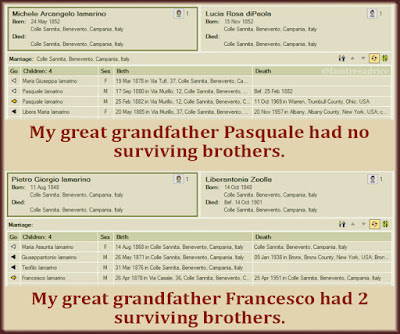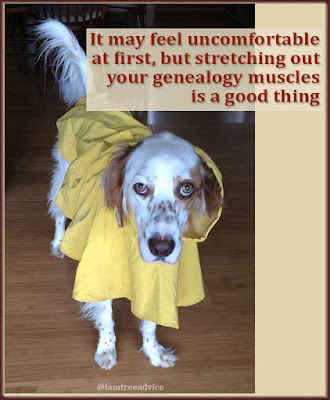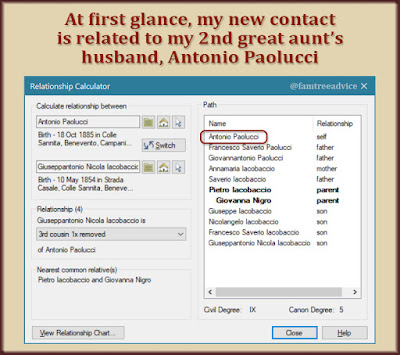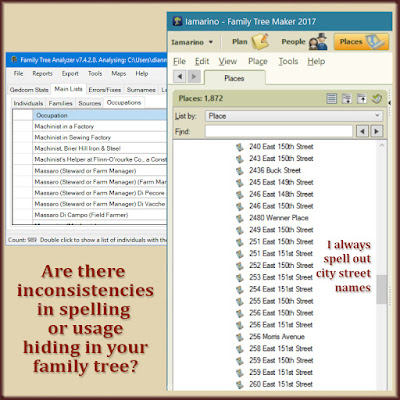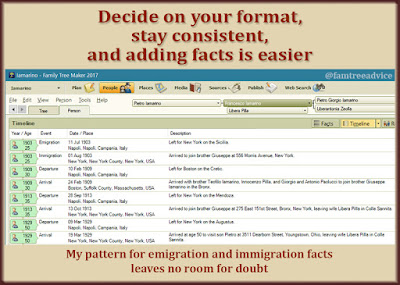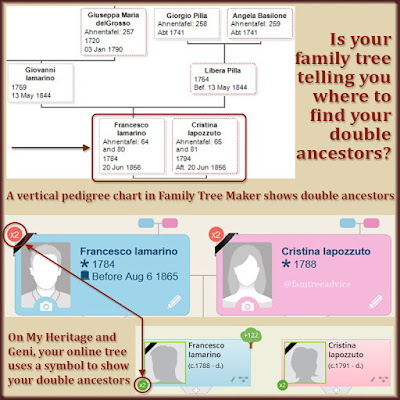It isn't only John Smiths that get mixed up. Naming customs are to blame.
No matter what ethnicity or nationality you ancestors were, you've probably seen this.
Everybody has the same name!
Many cultures followed a naming pattern that led to repeating names over and over. (Go to the FamilySearch Wiki and search for "naming customs" to see the rules.)
Here's an example. Imagine a man named Giuseppe Bianco whose father was Giovanni. Giuseppe names his 1st son Giovanni after his father. He names his 2nd son Salvatore after his wife's father. When young Giovanni and Salvatore grow up, they each name their 1st son Giuseppe after their father. No you've got 2 first cousins each named Giuseppe Bianco.
Now imagine that type of thing happening in every branch of your family, over and over again. The repeated names can drive any genealogy researcher crazy.
Picture yourself searching for a record of someone with a common name. How will you know you've found the right person?
Dates, Relatives, and More Documents
Search for your person in a wide array of years. Even if you think you know their birth year, check a bunch of surrounding years. Make note of every other person with the same or similar name. Who were their parents? Who did they marry?
 |
| Can't find an ancestor in the year you expected? Check a number of surrounding years. |
Search for every related document you can. Find other records that include the person's age to help you estimate their birth year. Examples are their children's births and marriages, and their death. Carefully consider every fact you find before deciding which one is your ancestor.
This past weekend I was building a family tree for a client. I was off to a good start because she knew several ancestors' names. When I found a birth record, I could see that the baby's parents matched the names my client gave me.
But one ancestor, let's call her Giulia Russo, was a problem. I couldn't find a birth record for her or her father. I did find Giulia's 1911 marriage record. It told me her parents' names (Francesco and Maria) and her approximate birth year.
I continued piecing together the rest of the family. Giulia and her father Francesco were the only 2 people missing a birth record. Actually, I found more than one birth record for a baby named Francesco Russo. But they were born so much earlier than Giulia's mother.
How could I know which Francesco Russo was the right one?
I needed Giulia's birth record so I could get an idea of when her father Francesco was born. Based on her marriage record, she should have been born in 1887 or 1888. She wasn't.
I had to assume they got Giulia's age wrong on her marriage record. I broadened my search and found the only baby girl with a name even close to Giulia Russo. She was born in late 1884. She was actually 26 when her marriage record said she was 23.
But I knew it was her. Why? Because I'd checked a wide range of years in 2 towns and this "Giulia Maria Russo" was the only option. She had the right parents. Their names matched those on the marriage record.
Finally I was able to say with some confidence that her father Francesco Russo was born in about 1842. That's much earlier than his wife, and much earlier than I'd expected.
I searched birth records from 1837 through 1865 looking for every Francesco Russo. I found only two. But they each had a problem. They each had a note saying who he married and when. And neither bride was Giulia's mother.
But Giulia's birth record put her father's birth year at 1842. The 2 Francesco's I found were born in 1842 and 1848. I took another look at the Francesco Russo born in 1842.
 |
| As a rule, it's always a good idea to search records in the surrounding years. |
When I considered everyone's ages, it became clear to me. The 1870 marriage to another woman written on his birth record was his 1st marriage. His 1st wife must have died before he married Giulia's mother Maria. Maria was 22 years younger than Francesco. She was 6 years old when he married the 1st time.
When Francesco married his 2nd wife, she was very young. She gave birth to their daughter Giulia at the age of 20. Ideally I'd want proof that Francesco's 1st wife died before Giulia was born. But the record isn't available. Neither is the marriage record for Francesco and Maria.
I searched a range of years for his 1st wife's death. No luck.
But I had one more ace up my sleeve. I could search for all the babies Francesco had with his 1st wife and see if they end by 1884. When the babies stop coming, that could be when his 1st wife died.
I found 4 babies born to Francesco and his 1st wife from 1872–1880. I kept searching, knowing that Giulia (the daughter of Francesco's 2nd wife) was born in 1884.
Good news, everyone! From 1881 to 1883 there no more babies for the 1st wife. Plus there was an 1883 baby born to the other Francesco Russo and his wife. The better clue came in 1885. A year after Francesco had a baby with his 2nd wife, the other Francesco Russo had another baby with his only wife.
This proves to me that I chose the right Francesco Russo.
In my experience with 19th century Italians, widows always remarried—sometimes awfully fast. And a man usually married a much younger woman and continued making the babies.
Francesco's experience fit perfectly into this mold. It's the same exact experience my 2nd great grandfather had. He married his 1st wife and had several children. Then his wife died. He quickly remarried, choosing a young lady who was his eldest daughter's age! Thank goodness he did, because that young 2nd wife was my 2nd great grandmother.
You won't always be 100% sure you've identified the right ancestor. But if you seek out as much information as possible, you're bound to have more success.
